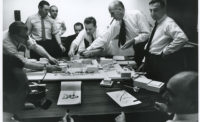Beyond plot devices, Hollywood has never had much use for cities as real locations. They're loud, crowded, unpredictable—all of which is anathema to a micromanaged industry. A few filmmakers have embraced the urban cacophony with gusto, though. Jules Dassin shot The Naked City (1948) verite style on the streets of New York, as did William Friedkin 23 years later when making The French Connection.
But they were only prelude to Michael Mann. From his first film, Thief (1981), to his latest, the technothriller Blackhat, in theaters now, the fetishistic auteur has embraced the grit, danger, and pathos of cities like no one before him.
If you know Mann from anything, it's as the aesthetician behind Miami Vice. As executive producer of the iconic TV show, he defined the style of the 1980s, from the pastels of Crocket’s suits to the Top 40 hit-machine soundtrack. But that’s all surface. Beneath the sheen is gritty, street-level storytelling that embraced the dark corners of its characters and their location.
One of the series’ most famous scenes is from the 1984 pilot, when Crockett (Don Johnson) and Tubbs (Philip Michael Thomas) rocket toward an uncertain fate in Crockett’s Ferrari Daytona Spyder convertible to the overwhelming beat of Phil Collins’ “In the Air Tonight.” It’s literally a street-level experience, one camera attached to the front bumper (anticipating countless GoPro setups that would come decades later), another lustily watching a speeding tire, both crosscut with contemplative, wind-swept shots of our heroes awash in the rushing glow of halogen light.
The moment is indelible: It’s fraught with tension, a master class in editing, as well as a view of cops at work that was completely new to TV audiences. But not to Mann. He spent time with cops and robbers in Chicago before becoming a filmmaker. He began his career shooting documentaries in prisons, and cut his narrative teeth on the crime show Police Story.
This experience allowed Mann to emerge essentially fully formed when Thief, a thriller focused on safecracker Frank (James Caan) pulled into one last, disastrous job, hit theaters. It’s a solid film, but what really grabs us is the sexy, dangerous claustrophobia of Chicago. Thief opens on a black screen scored to the sound of rain, followed by a synthesizer blast and a wet car popping on its headlights. Frank saunters from the shadows and into the driver seat, then eases the vehicle out of a back-alley parking lot onto a slick roadway lined with parallel rows of street lamps extending to infinity.
In about 20 seconds, Mann sets the tone for Thief, and lays the foundation for most of the films he’d make after it. (In the last decade or so, Mann’s urban filmmaking has a renewed sense of immediacy thanks to his use of digital cameras—not only for sun-drenched day action but also inky night scenes lit only by streetlights, neon signs, and smartphone screens.) From the Atlanta of Manhunter (1986) to the Los Angeles of Heat (1995) and Collateral (2004), the Miami of Miami Vice (he directed a big-screen version in 2006) to the panopticon of locations in Blackhat (Chicago, L.A., Jakarta, Hong Kong), Mann finds the dingy nooks, seductive underbelly, and hard-edged, cast-off personalities in need of redemption that pockmark urban landscapes. In his camera, cities are equal parts beauty and menace, overpopulated and impersonal, cool and cynical. They’re characters unto themselves, essential and irreplaceable.
Take the final showdown in Blackhat. Chris Hemsworth’s good-guy computer genius stalks the monomaniacal bad-guy hacker and his Eastern European henchman, who have cronies searching for our hero. It derives its energy and tension from two opponents smoking each other out amongst a crowd of 3,000 people in traditional garb massed in Jakarta’s Papua Square and more focused on celebration than the deadly beef of interlocutors. It’s a clash of wits and cultures that wouldn’t be the same if it took place anywhere else.
Filmmakers like Mann are typically dismissed as shallow stylists. But that oversimplification is off the mark. More than any other contemporary filmmaker, Mann has shown an uncanny knack of unlocking the vitality and cinematic potential of urbanism. His skillful deployment of aesthetics allows him to deftly explore the ancient and ongoing dynamic of cities: sordid and heroic and glamorous creatures in conflict with unfathomably large forces for control of their destiny. It’s a battle anyone who lives in a city will recognize. And yet, once Michael Mann has done with a place, it’s impossible to look at it the same way again.







Post a comment to this article
Report Abusive Comment